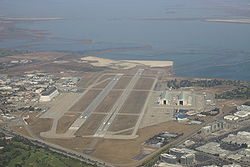
Back Moffett Federal Airfield CEB Moffett Federal Airfield German فرودگاه صحرایی فدرال موفت Persian Moffett Federal Airfield French Moffett Field Dutch Федеральный аэродром Моффетт Russian Фурудгоҳи саҳро фидирол муфт Tajik موفئٹ فیڈرل ایئرفیلڈ Urdu
Moffett Federal Airfield | |||||||||||||||
|---|---|---|---|---|---|---|---|---|---|---|---|---|---|---|---|
 | |||||||||||||||
| Summary | |||||||||||||||
| Airport type | Public/military | ||||||||||||||
| Operator | Google[1] | ||||||||||||||
| Location | Santa Clara County, near Mountain View and Sunnyvale, California, US | ||||||||||||||
| Elevation AMSL | 37 ft / 11 m | ||||||||||||||
| Coordinates | 37°24′54″N 122°02′54″W / 37.41500°N 122.04833°W | ||||||||||||||
 | |||||||||||||||
| Runways | |||||||||||||||
| |||||||||||||||
Moffett Federal Airfield (IATA: NUQ, ICAO: KNUQ, FAA LID: NUQ), also known as Moffett Field, is a joint civil-military airport located in an unincorporated part of Santa Clara County, California, United States, between northern Mountain View and northern Sunnyvale. On November 10, 2014, NASA announced that it would be leasing 1,000 acres (400 ha) of the airfield property to Google for 60 years.[3]
The airport is near the south end of San Francisco Bay, northwest of San Jose. Formerly a US Navy facility, the former naval air station is now owned and operated by the NASA Ames Research Center. Tenant military activities include the 129th Rescue Wing of the California Air National Guard, operating the HC-130J Combat King II and HH-60G Pave Hawk aircraft, as well as the adjacent Headquarters for the 7th Psychological Operations Group of the US Army Reserve. Until July 28, 2010, the US Air Force's 21st Space Operations Squadron was also a tenant command at Moffett Field, occupying the former Onizuka Air Force Station. In addition to these military activities, NASA also operates several of its own aircraft from Moffett.[4][5]
Hangars One, Two, and Three, and the adjacent Shenandoah Plaza are collectively designated as a National Historic District listed on the National Register of Historic Places.[6]
Hangar One is one of the world's largest freestanding structures, covering 8 acres (32,000 m2).[7] The hangar was constructed in 1931. Hangar One is a Naval Historical Monument, Historic American Engineering Record CA-335, State of California Historic Civil Engineering Landmarks. In May 2008, The National Trust for Historic Preservation listed Hangar One on their list of America's Most Endangered Places.[8]
Hangar Two is one of the world's largest freestanding wood structures, as was Hangar Three before it was demolished in 2024. The hangars were constructed when the US Navy established ten lighter-than-air bases across the United States during World War II as part of the coastal defense plan. Five of the original seventeen of these wooden hangars still exist: one at Moffett Field, one at Tustin, California, one at Tillamook, Oregon, and two at Lakehurst, New Jersey.[9]
The adjacent NASA Ames Research Center is also home to several wind tunnels, including the Unitary Plan Wind Tunnel (a National Historic Landmark), and the National Full-Scale Aerodynamic Complex.
- ^ O'Brien, Matt (31 March 2015). "Google takes over aging Moffett Field and its airship hangars". The Mercury News. Retrieved 4 October 2021.
- ^ Cite error: The named reference
FAAwas invoked but never defined (see the help page). - ^ "Google Takes Over NASA's Moffett Airfield for Robot and Space Research". NBC. 10 November 2014.
- ^ "Moffett Field History". NASA Ames Research Center. Archived from the original on 2008-03-11. Retrieved 2008-03-11.
- ^ "Moffett Field Naval Air Station (historical)". Geographic Names Information System. United States Geological Survey, United States Department of the Interior. Retrieved 2009-05-03.
- ^ US Naval Air Station Sunnyvale, CA Historic District (Moffett Field) Santa Clara County, California - National Register of Historic Places Travel Itinerary
- ^ "NASA'S HANGAR ONE RE-SIDING PROJECT" (PDF). Retrieved 2011-08-30.
- ^ Threats to history seen in budget cuts, bulldozers - Yahoo! News
- ^ "At A Glance - Facilities". NAVAIR. Archived from the original on September 24, 2012.